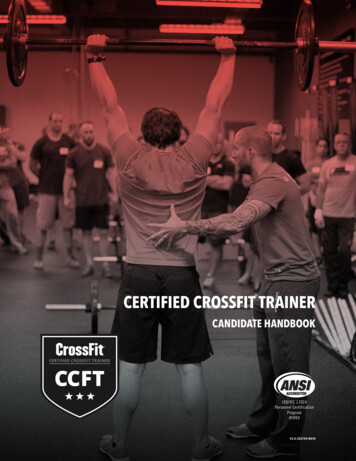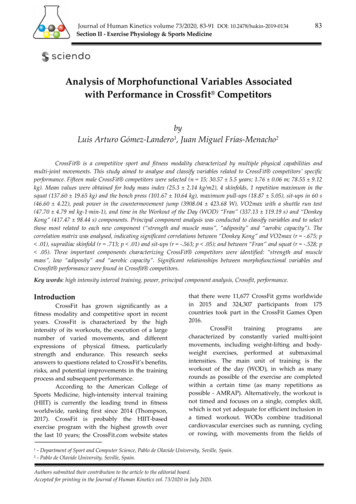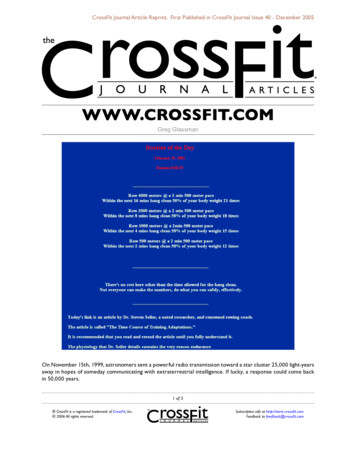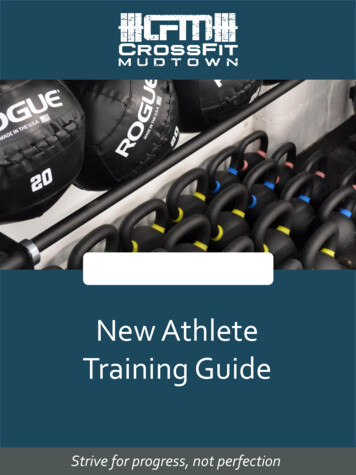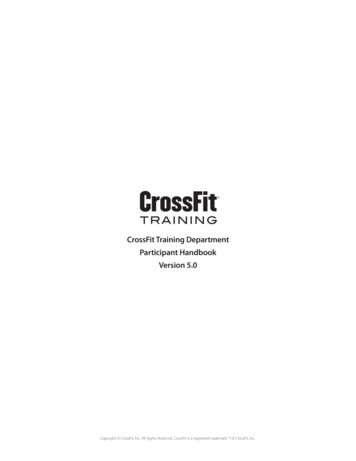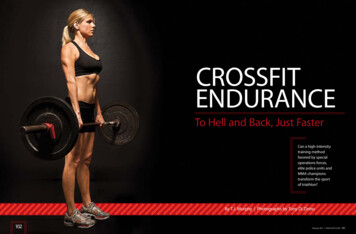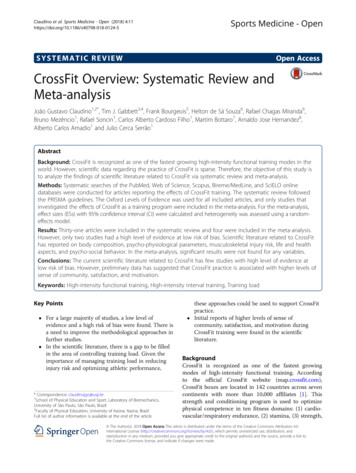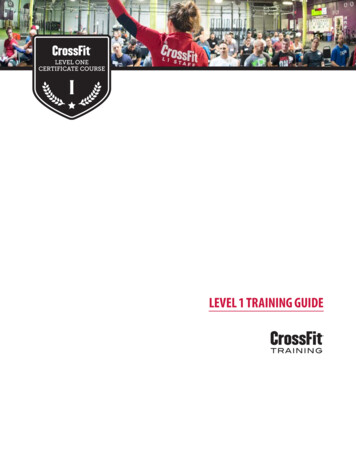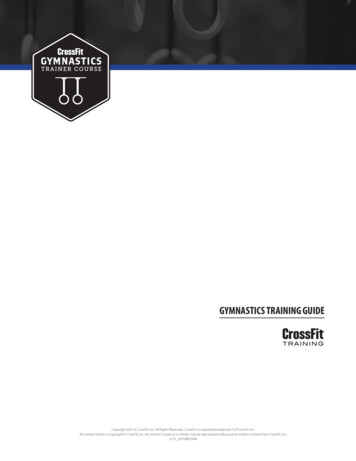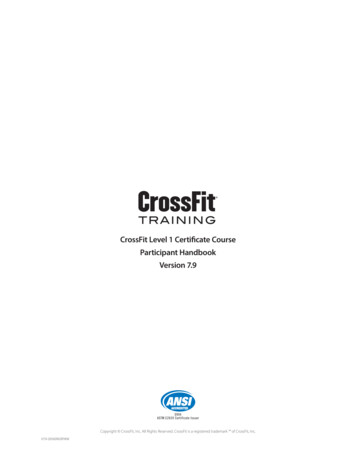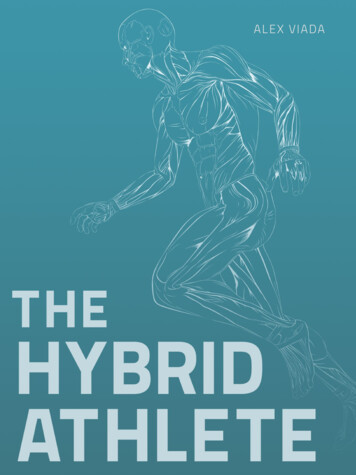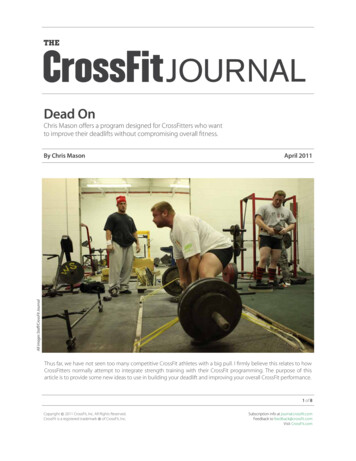
Transcription
Dead OnChris Mason offers a program designed for CrossFitters who wantto improve their deadlifts without compromising overall fitness.April 2011All images Staff/CrossFit JournalBy Chris MasonThus far, we have not seen too many competitive CrossFit athletes with a big pull. I firmly believe this relates to howCrossFitters normally attempt to integrate strength training with their CrossFit programming. The purpose of thisarticle is to provide some new ideas to use in building your deadlift and improving your overall CrossFit performance.1 of 8Copyright 2011 CrossFit, Inc. All Rights Reserved.CrossFit is a registered trademark of CrossFit, Inc.Subscription info at journal.crossfit.comFeedback to feedback@crossfit.comVisit CrossFit.com
Dead On .(continued)A.J. Roberts of Westside Barbell working on box squats with a safety squat bar.I suppose one’s interpretation of a “big pull” can vary quitesignificantly. I come from a powerlifting background, butI am not expecting CrossFitters to become the recordholding deadlifters in their respective weight classes. It’sobviously not realistic to expect a good CrossFitter to pull800-plus lb., but I do think it’s realistic that we should see alot more 550-plus-lb. pulls from the men and 350-plus-lb.pulls from the women.Linear-Progression FollyLinear progression and the idea of “just sticking with thebasics” (with respect to strength training) have been more orless ingrained into the CrossFit culture up until very recently.With the addition of Louie Simmons of Westside Barbell tothe seminar team, that has started to change. My goal isto further promote the change and provide a manner inwhich CrossFitters can take Louie’s training methodologiesand integrate them with their CrossFit WODs.As stated above, until very recently many CrossFitters’strength training (not counting clean and snatch variations;they are a different form of strength training than what I amreferring to here) consisted primarily of pressing, deadliftingand squatting following a linear-progression program.CrossFit main-site programming, of course, does notfollow that pattern, and athletes are not presented witha linear program where they try to increase the weighton the lifts each session. But when many CrossFittersstart a supplementary or strength-bias programdesigned to increase their strength, they fall back onthe old linear model. This is a recipe for mediocrity. Yes,you can progress in each exercise on a linear plan, butsaid progression will not take the trainee beyond intermediate strength levels (with a very, very few geneticfreak exceptions).2 of 8Copyright 2011 CrossFit, Inc. All Rights Reserved.CrossFit is a registered trademark of CrossFit, Inc.Subscription info at journal.crossfit.comFeedback to feedback@crossfit.comVisit CrossFit.com
Dead On .(continued)The Westside SolutionA huge component of the efficacy of Louie Simmons’Westside Barbell training methodology is its use ofconjugate variety (CV). In the classic Westside template,CV is used primarily on maximum-effort (ME) training daysand involves the rotation of compound exercises by bodypart weekly. The norm is four exercises (those the lifterfinds are best for him or her) used for the rotation. Eachfour-week rotation thus becomes a mini-cycle, and at thecompletion of each mini-cycle, the process starts all overagain the following week.The weekly rotation ofcompound exercises helpsprevent neural stagnationdue to the unique effect eachexercise has on the centralnervous system.Sometimes correcting very specific weaknesses requiresyou to think outside the box.Linear progression is limited in the results it can providefor two main reasons. The first is that most linear programspromote the use of the same exercises over and over.Training any compound movement at a high intensity insuch a repetitive fashion leads to neural stagnation andpossible regression. In other words, the nervous systemgets overwhelmed and adaptation ceases, or the individualliterally goes backwards in his training.The second main reason classic linear progression fails istied to the first. Repetition of the same exercises is againthe culprit. In this case, repeating the same compoundmovements never addresses individual weaknesses.Everyone has a relative weakness on every compoundmovement. Repeatedly performing the same movementdoes nothing to address said relative weakness but onlyimproves the weak part in proportion to the strongpart. This ultimately—and usually in short order—limitsabsolute progress and might promote injury.CV addresses both of the major shortcomings of linearprogression systems noted above. The weekly rotationof compound exercises helps prevent neural stagnationdue to the unique effect each exercise has on the centralnervous system (CNS). Even small variances in movementare perceived very differently by the CNS, thus stressing itin a unique way. Additionally, each exercise places greateremphasis on different body parts, thus helping addressindividual weaknesses.For example, if a trainee’s weakness in the squat is the lowerback, then the incorporation of both good mornings anddeadlifts into the rotation addresses the problem by usingexercises that more specifically target the weakness inthe squat.Westside also utilizes dynamic-effort (DE) or speedtraining. A separate day is allotted for this style of training.The purpose of DE is to help build explosive strength, toallow for higher volume, and to function as a form of activerecovery (it is much less taxing on the CNS than ME work).3 of 8Copyright 2011 CrossFit, Inc. All Rights Reserved.CrossFit is a registered trademark of CrossFit, Inc.Subscription info at journal.crossfit.comFeedback to feedback@crossfit.comVisit CrossFit.com
Dead On .(continued)The RoutineDay 2With the above basic preamble done, it’s time for theprogram. I have designed a 12-week template that incorporates ME, DE and CV with a focus on the deadlift. Theprogram also provides for three days per week of conventional WODs, thus allowing the trainee to experience nodetraining effect relative to CrossFit fitness.DE exercise: box squats with bandsDay 1 below will always be ME day.Week 3Day 2 below will always be DE day. Days 1 and 2 shouldhave at least 72 hours between them.Sets and reps when applicable are listed in the followingformat: 2x15. This indicates 2 post-warm-up sets are to bedone for 15 repetitions each. Other than speed work, allaccessory sets listed in this format should be taken to thepoint where another rep cannot be completed withoutassistance.Week 1Day 1ME exercise: box squat with bands (video)Accessory work:Speed pull from the floor—15x1Hamstring curl with dumbbell held between feet—2x15-20Ab work—2x20Day 2DE exercise: box squat with bands (video)Accessory work:Glute bridge—2x20 (video)Glute-ham raise—2xAMRAP (video)Accessory work:Pull-through—2x20Ab work—2x20Day 1ME exercise: good morningAccessory work:Speed rack pull with bands—8x3 (from roughly 3 inchesbelow the knees)Hamstring curl with dumbbell held between feet—2x20Ab work—2x20Day 2DE exercise: box squat with bandsAccessory work:Glute bridge—2x15Glute-ham raise—2xAMRAPAb work—2x20Week 4Day 1ME exercise: deadlift from floorAccessory work:Glute-ham raise—2xAMRAPAb work—2x20Sumo-stance good morning with a Jump Stretchband—1x100Week 2Ab work—2x20Day 1Day 2ME exercise: rack pull with bands (from roughly 3 inchesbelow the knees)DE exercise: box squat with bandsAccessory work:Glute-ham raise—2xAMRAPHeavy sled pull—6x20 yards (do not run with the sled)Ab work—2x20Accessory work:Glute bridge—2x15Seated hamstring curl with Jump Stretch band—2xAMRAPAb work – 2x20The mini-cycle is now complete. Repeat for 2 more cycles.4 of 8Copyright 2011 CrossFit, Inc. All Rights Reserved.CrossFit is a registered trademark of CrossFit, Inc.Subscription info at journal.crossfit.comFeedback to feedback@crossfit.comVisit CrossFit.com
Dead On .(continued)Routine TutorialME WorkME training involves the lifter warming up to aone-repetition-maximum (1RM) attempt. This style oftraining is the most effective means of increasing absolutestrength. To be clear, once the 1RM attempt is complete,the lifter is done with the movement for the day.Example:Deadlift from the floor135x5185x5225x3The first two weeks will consist of 12 sets of 2 reps (afterwarm-up) with the third week being 10 sets of 2 reps.A major goal of speed work is to improve one’s rate offorce production. To that end, each rep must be fast. Thenegative or eccentric portion of the movement shouldbe controlled (do not drop to the box) but fast, with theconcentric portion being as fast and explosive as possible(again, always under control). Minimize rest between sets,but take enough that speed does not suffer. The last setshould be as fast as the first.Prior to commencing the second wave in Week 4, youshould retest your 1RM box squat. That can be doneprior to your ME deadlift for the day. If you have access todifferent bars (safety squat bar, cambered bar, etc.), use adifferent bar for each test and subsequent wave.275x1315x1335x1RM attemptDone!DE WorkTwo kinds of speed work are incorporated into thisprogram. For the designated DE days, the speed workin this routine is performed with a box squat and JumpStretch bands. In addition to the DE-day squats, speedpulls are used as an accessory movement on a couple ofthe ME days.Prior to commencing the program, you will have totest your 1RM box squat because DE squat training is apercentage-based system. It consists of 3-week wavesusing 60, 65 and 70 percent of your 1RM bar weight plusthe bands. For the purposes of this routine, “strong” bandsshould be used for all DE training (you can find them atWestside Barbell).To illustrate a three-week wave, let’s assume you have atested 1RM box squat of 300 lb. (no bands being used forthe 1RM test). Your three-week wave will be as follows:Week 1—180 lb. bar weight strong bandsWeek 2—195 lb. bar weight strong bandsWeek 3—210 lb. bar weight strong bandsAccessory work is designed to address the specificweaknesses that are holding you back.5 of 8Copyright 2011 CrossFit, Inc. All Rights Reserved.CrossFit is a registered trademark of CrossFit, Inc.Subscription info at journal.crossfit.comFeedback to feedback@crossfit.comVisit CrossFit.com
Dead On .(continued)The Use of BandsJump Stretch bands, commonly known as just “bands,”are an integral component of this program. Bands takestandard barbell training to the next level by simultaneously increasing intensity and efficiency.If you are unfamiliar with bands, they are essentially giantversions of the common rubber band we are all familiarwith. When they are secured on one end and attached toa barbell on the other, they change the resistance curvedramatically. This change forces the lifter to work harderthroughout the range of motion (ROM) of the exercise.Think of the standard barbell squat. As you stand back upwith the weight, the movement becomes progressivelyeasier due to improved leverage as the involved jointangles change. This phenomenon of the physics of themovement causes a significant portion of the ROM to beessentially an unloading phase. With the addition of bands,this inherent weakness is eliminated. As the movementwould normally get easier, the bands are stretching andincreasing the resistance, thus forcing the lifter to exertmuch greater effort throughout the ROM.Bands can also serve to promote what Louie Simmonscalls “overspeed eccentrics”—lowering the weight fasterthan might otherwise be possible. While not necessarilyoptimal for bodybuilding training, this style of trainingis quite beneficial for strength applications. The speedof descent very directly correlates with the speed of theconcentric (or positive) portion of the ROM. In other words,the faster you lower the bar the faster you lift it.Bands play a big role in Westside training and completely change the dynamics of a movement.6 of 8Copyright 2011 CrossFit, Inc. All Rights Reserved.CrossFit is a registered trademark of CrossFit, Inc.Subscription info at journal.crossfit.comFeedback to feedback@crossfit.comVisit CrossFit.com
Dead On .(continued)Sloppy form with big loads isa recipe for training disaster.A point of caution: many less experienced lifters will try toemploy this technique and end up hurting themselves.The caveat with overspeed eccentrics is that the lifter mustalways remain in control. Sloppy form with big loads is arecipe for training disaster. I always recommend a lifterlearn how to perform a given exercise using slow andcontrolled form first. It is only after they have masteredthe basic technique that I have them begin to exploregreater speed of movement. This leads to lifters whoare able to maintain perfect form even at high speeds(I am not speaking of the Olympic lifts here—they areanother story).Bands can also provide another form of conjugate variety.You can do the exact same movement with varying bandtension, resulting in exercise that is perceived by thenervous system quite differently.Here is a video demonstrating how to set up bands forsquatting: video.One note on band set-up: always be sure to use sufficientband tension at the bottom of the ROM such that thebands never totally unload and get slack.Once your form is solid, work on moving the weight with explosive speed.7 of 8Copyright 2011 CrossFit, Inc. All Rights Reserved.CrossFit is a registered trademark of CrossFit, Inc.Subscription info at journal.crossfit.comFeedback to feedback@crossfit.comVisit CrossFit.com
Dead On .(continued)Exercises UsedThis article contains video links to examples of someof the lesser-known exercises in the program. Properperformance of each exercise is of extreme importance.Improper technique can lead to both short- and long-terminjury. Do not let your ego dictate your training. Do notsacrifice form for weight or speed.Give this program a try and let me see some morecompetitive CrossFitters with 600-lb.-plus deadlifts!FIf you have any questions about exercises that do not havevideo links, or even for those that do, please ask them inthe CrossFit Journal comments section for this article or onthe CrossFit Message Board. I will do my best to answer anyand all questions.WOD Incorporation and Training TimingCrossFit WODs are not my area of expertise. I am familiarwith them and certainly understand the physiologicalmachinations of the exercise form, but I feel it best toleave the choice of WODs to you, the experts. My onlycaveat is that some consideration is given to avoiding trulystrength-focused WODs like King Kong.I do wish to address WOD timing relative to the MEand DE days. ME and DE training sessions should be 72hours apart. The days of the week are not of particularimportance, but if you have your ME day at 5 p.m. onMonday, your DE training should fall at 5 p.m. the followingThursday. Optimal WOD timing would see a WOD followboth the ME and DE days, with the third WOD falling oneither Wednesday or Saturday following the MondayThursday/ME-DE training protocol used here.Go Lift!About the AuthorChris Mason is the owner of AtLarge Nutrition. Chris has beeninvolved with bodybuilding and powerlifting for over twodecades. He is an accomplished writer in the genre, havingpublished articles in Athlete, Planet Muscle, Ironmanand Powerlifting USA magazines, as well as online. Youcan view several of his articles on his website WannaBeBig.com. Chris currently resides in Charlottesville, Va., and makesmonthly treks to Ohio to train at Westside Barbell with LouieSimmons. He is also a member of Louie’s team for CrossFitPowerlifting Seminars.The stated goal of this program is to build your deadliftwhile simultaneously allowing you to improve your CrossFitWOD times. If followed as prescribed, it will do exactlythat. As you build the absolute power of your posteriorchain and continue to practice your CrossFit training, youwill find there is a direct correlation between increasedabsolute strength and improved WOD performance.Regardless of other factors, as absolute strength increases,all loads become “lighter” or, more accurately, become alower percentage of your 1RM (lower intensity). The lowerthe intensity, the longer you can continuously perform agiven exercise. And in a CrossFit workout, if the load feelslight, you can ramp the intensity back up by cranking upthe speed.8 of 8Copyright 2011 CrossFit, Inc. All Rights Reserved.CrossFit is a registered trademark of CrossFit, Inc.Subscription info at journal.crossfit.comFeedback to feedback@crossfit.comVisit CrossFit.com
The Westside Solution A huge component of the efficacy of Louie Simmons’ Westside Barbell training methodology is its use of conjugate variety (CV). In the classic Westside template, CV is used primarily on maximum-effort (ME) training days and involve
